Related Research Articles

The Brisbane Water National Park is a protected national park that is located in the Central Coast region of New South Wales, in eastern Australia. The 11,506-hectare (28,430-acre) national park is situated 47 kilometres (29 mi) north of Sydney, 10 kilometres (6.2 mi) west of Woy Woy, and 12 kilometres (7.5 mi) southwest of Gosford.
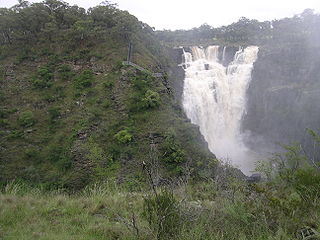
The Oxley Wild Rivers National Park is a protected national park that is located in the Northern Tablelands region of New South Wales, Australia in the Port Macquarie-Hastings City Council and Walcha Shire councils. The 145,223-hectare (358,850-acre) park is situated 445 kilometres (277 mi) north of Sydney and is named in memory of the Australian explorer John Oxley, who passed through the area in 1818 and is one of the largest national parks in New South Wales.

Eungella National Park is a protected area in Queensland, Australia. It is on the Clarke Range at the end of the Pioneer Valley 80 km west of Mackay, and 858 km northwest of Brisbane. Eungella is noted for the national park which surrounds it. It is considered to be the longest continual stretch of sub-tropical rainforest in Australia. The original inhabitants are the Wirri people. The park is covered by dense rainforest and is known for its platypuses.
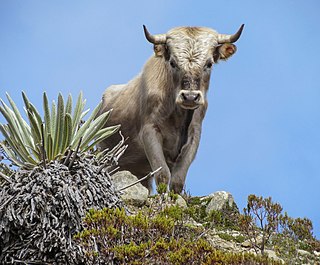
A feral animal or plant is one that lives in the wild but is descended from domesticated individuals. As with an introduced species, the introduction of feral animals or plants to non-native regions may disrupt ecosystems and has, in some cases, contributed to extinction of indigenous species. The removal of feral species is a major focus of island restoration.

A goanna is any one of several species of lizards of the genus Varanus found in Australia and Southeast Asia.
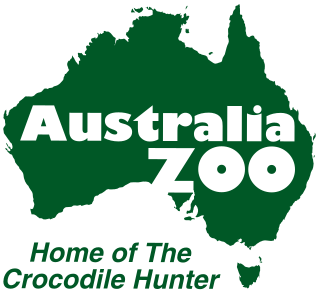
Australia Zoo is a 700-acre (280 ha) zoo located in the Australian state of Queensland on the Sunshine Coast near Beerwah/Glass House Mountains. It is a member of the Zoo and Aquarium Association (ZAA), and is owned by Terri Irwin, the widow of Steve Irwin, whose wildlife documentary series The Crocodile Hunter and his family’s new show Crikey! It's the Irwins made the zoo a popular tourist attraction.

Russell Alan Mittermeier is a primatologist and herpetologist. He has written several books for both popular and scientist audiences, and has authored more than 300 scientific papers.

Western Shield, managed by Western Australia's Department of Parks and Wildlife, is a nature conservation program safeguarding Western Australia's animals and protecting them from extinction. The program was set up in 1996 and as of 2009 was the largest and most successful wildlife conservation program ever undertaken in Australia.
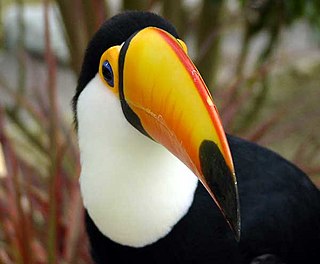
The wildlife of Brazil comprises all naturally occurring animals, plants, and fungi in the South American country. Home to 60% of the Amazon Rainforest, which accounts for approximately one-tenth of all species in the world, Brazil is considered to have the greatest biodiversity of any country on the planet. It has the most known species of plants (55,000), freshwater fish (3,000), and mammals. It also ranks third on the list of countries with the most bird species (1,832) and second with the most reptile species (744). The number of fungal species is unknown but is large. Approximately two-thirds of all species worldwide are found in tropical areas, often coinciding with developing countries such as Brazil. Brazil is second only to Indonesia as the country with the most endemic species.

The fauna of Canada consist of approximately 200 mammal species, over 460 native bird species, 43 amphibian species, 43 reptile species, and 1,200 fish species. The biology survey of Canada cites that there are approximately 55,000 species of insects, and 11,000 species of mites and spiders.
John Burton was a British conservationist and nature author.
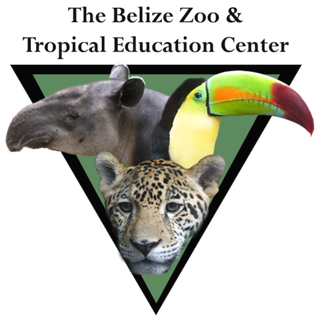
The Belize Zoo and Tropical Education Center is a zoo in Belize, located some 47 kilometres (29 mi) west of Belize City on the Western Highway. Set in 12 hectares, the zoo was founded in 1983 by Sharon Matola. It is home to more than 175 animals of about 48 species, all native to Belize. The natural environment of Belize is left entirely intact within the zoo. The dense, natural vegetation is separated only by gravel trails through the forest. The Belize Zoo and Tropical Education Center receives over 68,000 visitors annually, with 15,000 being students, teachers, and parents.
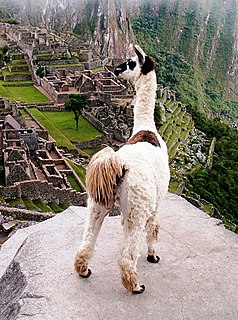
Peru has some of the greatest biodiversity in the world. It belongs to the select group of mega diverse countries because of the presence of the Andes, Amazon rainforest, and the Pacific Ocean. It has the fourth-most tropical forests of any country and the ninth-most forest area.

The Kimberley tropical savanna is a tropical and subtropical grasslands, savannas, and shrublands ecoregion in northwestern Australia, covering portions of Western Australia and the Northern Territory south of the Timor Sea.

The Yathong Nature Reserve is a protected nature reserve that is also a nationally and internationally recognized biosphere situated in the central-western region of New South Wales, in eastern Australia. The 107,240-hectare (265,000-acre) reserve was listed by UNESCO in 1977 as a Biosphere Reserve under the Man and the Biosphere Programme (MAB). The reserve is significant for its biodiversity in both native plant and animal species. Cultural heritage and historical grazing activities add to the significance of this site as a conservation area.
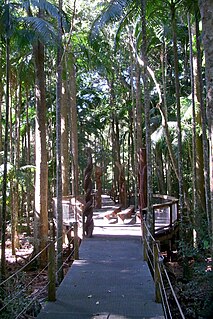
The Sea Acres National Park is a national park that is located in the Mid North Coast region of New South Wales, in eastern Australia. The 76-hectare (190-acre) park is situated near the town of Port Macquarie. The park is a popular tourist area with a 1.3-kilometre (0.81 mi) long boardwalk through a remnant of seaside rainforest. There is also an education centre and cafe. The park was initially declared as a nature reserve in 1987; and gazetted as a national park in October 2010.
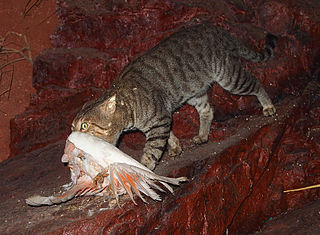
Cats are an invasive species in Australia. Because they are not native to Australia and were only introduced by colonisers as pets in the early 1800s, native Australian animals did not co-evolve with them. As of 2016, some 3.8 million domestic cats and up to 6.3 million feral cats continue to live in Australia. Every year domestic and feral cats in Australia kill 1,067,000,000 mammals, 399,000,000 birds, 609,000,000 reptiles, and 92,000,000 frogs. As one of the most ecologically damaging and costly invasive species in Australia, predation by both domestic and feral cats has played a role in the extinction of many of Australia's Indigenous animals. For instance, cats are found to have significantly contributed to the extinction of at least 22 endemic Australian mammals since the arrival of Europeans.
Wadderin Sanctuary is a nature conservation project within the Shire of Narembeen in the eastern wheatbelt of Western Australia. It is about 290 km east of Perth and 8 kilometres north of the town of Narembeen. Wadderin is surrounded by a fox- and cat-proof fence that was completed in early 2008. This has allowed the reintroduction of fauna that is uncommon or locally extinct in the wheatbelt, and includes species that are considered threatened at the national level.
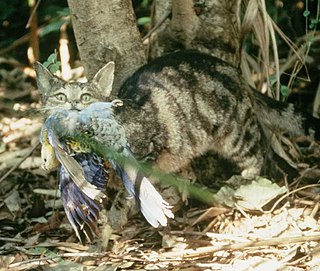
Cat predation on wildlife is the result of the natural instincts and behavior of both feral and domesticated cats to hunt small prey, including wildlife. Some people view this as a desirable phenomenon, such as in the case of barn cats and other cats kept for the intended purpose of pest control; however, contrary to popular belief, there is no scientific evidence that cats are an effective means of rodent control, and ecologists oppose their use for this purpose because of the disproportionate harm they do to beneficial native wildlife. As an invasive species and superpredator, they do considerable ecological damage.

Limeburners Creek National Park is a protected national park on the Mid North Coast of New South Wales, Australia. The 91.2 km national park is located 5 km (3.1 mi) to the north of Port Macquarie and exists across both the Kempsey Shire and Port Macquarie-Hastings Council local government areas, but is chiefly managed by National Parks and Wildlife Service. The area was originally erected as a nature reserve but this reservation was revoked when it became formally recognised as a national park in 2010 under the National Parks and Wildlife Act (1974). Many threatened ecological habitats and species of fauna and flora are found within this park, alongside several heritage sites of cultural significance, particularly to the local Birpai and Dunghutti people upon whose land the park exists. The protected status of this national park is largely owing to the ecological and cultural value of the area, in addition to the value of the ecosystems to further scientific research.
References
Footnotes
- ↑ "New South Wales Premier's Awards" (PDF). SL Magazine. Vol. 8, no. 4. Summer 2015. p. 36.
- ↑ Faulkner, Jane; February 6, 2003; "Noxious Nasties"; The Age; newsstrore.fairfax.com.au. Access date: November 17, 2016
- ↑ Patron profile, Rainforest Rescue
- ↑ Beolens, Bo; Watkins, Michael; Grayson, Michael (2011). The Eponym Dictionary of Reptiles. Baltimore: Johns Hopkins University Press. xiii + 296 pp. ISBN 978-1-4214-0135-5. ("Low, T.", p. 161).
Notations
- Low, Tim, Wild Food Plants of Australia, ISBN 978-0-207-14383-0